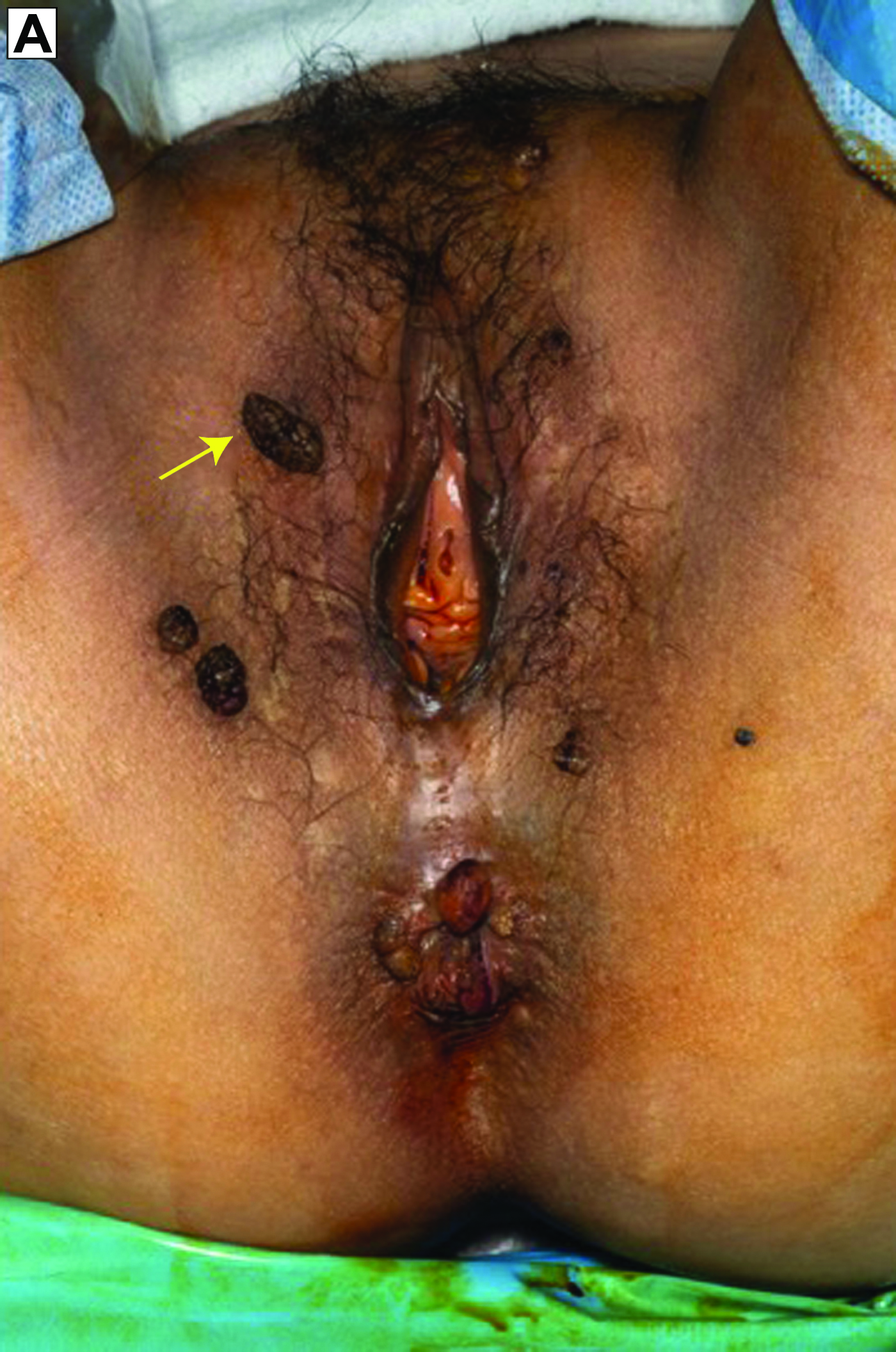Recurrent Condylomata Acuminata in a Transplant Patient
-
Ritchie Delara
A 49-year-old woman presented with recurrent vulvar and perianal condyloma for 1 year (image A). Her medical history included deceased donor renal transplant. She was taking 500 mg of mycophenolate orally twice per day and 2 mg of tracrolimus orally twice per day for immunosuppressive therapy. She had prior wide local excision of bilateral vulva with laser fulguration of a condyloma and subsequent trichloroacetic acid ablation. An anal Papanicolaou test was positive for low-grade squamous intraepithelial lesion (image B). Vulvar and anorectal condyloma excision was performed (image C and image D). Vulvar condylomas were negative for dysplasia and high-risk human papillomavirus. Perianal condylomas were positive for squamous cell carcinoma in situ and positive for (other high-risk) human papillomavirus (image E).





Women who are immunosuppressed and aged 40 years or older with a history of vulvar or cervical dysplasia have an increased risk for anogenital cancer.1-5 Abnormal cytologic findings should prompt high-resolution anoscopy or referral to colorectal surgery.1,3 When managing benign conditions like vulvar condylomas, gynecologists should strongly consider anal cancer screening using history, examination, and anal cytology with cotesting.
References
1. MoscickiAB, DarraghTM, Berry-LawhornJM, et al.. Screening for anal cancer in women. J Low Genit Tract Dis.2015;19(3 suppl 1):S27-542. doi:10.1097.LGT0000000000000117Search in Google Scholar
2. NadhanKS, LarijaniM, AbbottJ, DoyleAM, LinfanteAW, ChungCL. Prevalence and types of genital lesions in organ transplant recipients. JAMA Dermatol.2018;154(3):323-329. doi:10.1001/jamadermatol.2017.5801Search in Google Scholar PubMed PubMed Central
3. StierEA, SebringMC, MendezAE, BaFS, TrimbleDD, ChiaoEY. Prevalence of anal human papillomavirus infection and anal HPV-related disorders in women: a systematic review. Am J Obstet Gynecol. 2015;213(3):278-309. doi:10.1016/jajog.2015.03.034.Search in Google Scholar
4. VeguntaS, FilesJA, WassonMN. Screening women at high risk for cervical cancer: special groups of women who require more rrequent screening. Mayo Clin Proc. 2017;92(8):1272-1277. doi:10.1016/j.mayocp.2017.06.007Search in Google Scholar PubMed
5. WorkowskiKA, Bolan GA; Centers for Disease Control and Prevention. Sexually transmitted diseases treatment guidelines, 2015 [published correction appears in MMWR Recomm Rep. 2015;64(33):924]. 2015;64(RR-03):1-137. MMWR Recomm Rep. 2015;64(RR-03):1-137.Search in Google Scholar
© 2020 American Osteopathic Association
Articles in the same Issue
- ORIGINAL CONTRIBUTION
- Osteopathic Medical Licensing Compliance With the Americans With Disabilities Act of 1990
- A Pilot Study of Jugular Compression (Queckenstedt maneuver) for Cranial Movement Perception
- CASE REPORT
- Diagnosis of Myocardial Infarction in a Patient With Left Bundle Branch Block and Negative Sgarbossa Criteria
- REVIEW
- Musculoskeletal Conditions in Patients With Diabetes: A Narrative Review
- The Role of Musculoskeletal Disorders in Chronic Disease: A Narrative Review
- CASE REPORT
- Orthotics to Improve Pain in a Patient With Multiple Internal Fixations and Multilevel Thoracic Fusion
- ORIGINAL CONTRIBUTION
- Ultrasound Shear Wave Elastography to Assess Tissue Mechanical Properties in Somatic Dysfunction: A Feasibility Study
- BRIEF REPORT
- Osteopathic Manipulative Treatment for a Recognizable Pattern of Somatic Dysfunction Following Laparoscopic Cholecystectomy
- CASE REPORT
- A Case of Resolved Vincristine-Induced Constipation Following Osteopathic Medicine in a Patient With Infantile Fibrosarcoma
- OMT MINUTE
- Osteopathic Manipulative Treatment for Inhaled Rib Somatic Dysfunction
- BRIEF REPORT
- Opioid Use in the Postpartum Period: Are We Prescribing Too Much?
- ORIGINAL CONTRIBUTION
- Effect of Hydration on Doppler Velocity of Renal Arteries
- CLINICAL IMAGE
- Recurrent Condylomata Acuminata in a Transplant Patient
- LETTER TO THE EDITOR
- Value of Tenets of Osteopathic Medicine for Patients During COVID-19 Crisis
Articles in the same Issue
- ORIGINAL CONTRIBUTION
- Osteopathic Medical Licensing Compliance With the Americans With Disabilities Act of 1990
- A Pilot Study of Jugular Compression (Queckenstedt maneuver) for Cranial Movement Perception
- CASE REPORT
- Diagnosis of Myocardial Infarction in a Patient With Left Bundle Branch Block and Negative Sgarbossa Criteria
- REVIEW
- Musculoskeletal Conditions in Patients With Diabetes: A Narrative Review
- The Role of Musculoskeletal Disorders in Chronic Disease: A Narrative Review
- CASE REPORT
- Orthotics to Improve Pain in a Patient With Multiple Internal Fixations and Multilevel Thoracic Fusion
- ORIGINAL CONTRIBUTION
- Ultrasound Shear Wave Elastography to Assess Tissue Mechanical Properties in Somatic Dysfunction: A Feasibility Study
- BRIEF REPORT
- Osteopathic Manipulative Treatment for a Recognizable Pattern of Somatic Dysfunction Following Laparoscopic Cholecystectomy
- CASE REPORT
- A Case of Resolved Vincristine-Induced Constipation Following Osteopathic Medicine in a Patient With Infantile Fibrosarcoma
- OMT MINUTE
- Osteopathic Manipulative Treatment for Inhaled Rib Somatic Dysfunction
- BRIEF REPORT
- Opioid Use in the Postpartum Period: Are We Prescribing Too Much?
- ORIGINAL CONTRIBUTION
- Effect of Hydration on Doppler Velocity of Renal Arteries
- CLINICAL IMAGE
- Recurrent Condylomata Acuminata in a Transplant Patient
- LETTER TO THE EDITOR
- Value of Tenets of Osteopathic Medicine for Patients During COVID-19 Crisis

